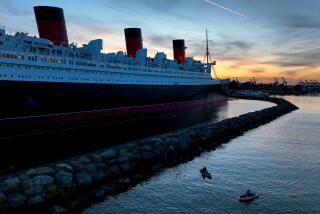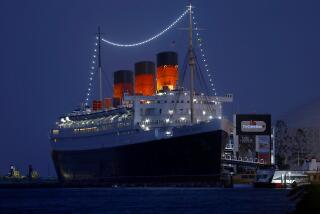Cruise lines launch floating behemoths to pack in options
Donât look now, but an armada of ever-bigger cruise ships is steaming over the horizon. And there are bigger ones just behind them. Passengers, don your walking shoes.
Cunard Lineâs record-breaking Queen Mary 2 -- all 150,000 gross tons of it, 147 feet longer than the Eiffel Tower is tall -- will hit the water in January with a capacity of 2,620 passengers and 1,253 crew. Two years later, Royal Caribbean Cruises expects to top Cunard with its first Ultra Voyager-class behemoth: nearly 160,000 gross tons, carrying a small city of 3,600 guests and 1,400 crew members. (Gross tons, in a nautical peculiarity, measure volume, not weight.)
And speaking of cities: U.S. backers of America World City-the Westin Flagship, a 255,000-gross ton, 6,200-passenger ship conceived in the 1980s, are still pitching for federal loan guarantees to help realize the dream. The price tag, $1.25 billion, which once raised eyebrows, today seems reasonable for the size, given the $800-million cost of the smaller Queen Mary 2.
Itâs hard to believe that little more than five years ago, Princess Cruisesâ Grand Princess, at 109,000 gross tons and 2,600 passengers, was sailing away with the âbiggest everâ crown.
Is there any end in sight?
âFrom the naval architectâs point of view, we are not even near the maximum size,â says Henrik Segercrantz, spokesman for Finlandâs Kvaerner Masa-Yards Inc., which is building the Ultra Voyager. The only near-term restraints he sees are port restrictions and market factors, such as whether the ship can attract enough passengers.
Already many passenger vessels are too portly to navigate the Panama Canal locks, which have a 100,000-gross-ton limit, so cross that passage off your list if youâre a big-ship aficionado.
Cruise companies arenât too worried about bypassing the Panama Canal, though, because in so many ways bigger is better -- for them and for us.
An obvious advantage stems from economies of scale in construction. The more guest cabins, the less cost per cabin. Depending on how the ship is built, savings may amount to $50,000 per lower bed for a ship measuring about 140,000 gross tons compared with one at 50,000 gross tons, according to data from Kvaerner Masa-Yards. The Ultra Voyager pencils out to a little more than $200,000 per guest berth.
Thereâs also more room for spas, retail shops, premium (pay per meal) restaurants and other extras, beyond the fare, that tempt passengers to pull out their wallets. Companies are cagey about how much they make from such amenities, but industry experts say it may be up to 20% of ship revenue.
The biggest reason for big, however, is that more activities can be loaded onto ships that have morphed from transportation into floating resorts.
âYou used to take a cruise from Point A to Point B,â says John Maxwell, an industry analyst specializing in gaming, lodging and leisure in Merrill Lynchâs New York office. âNow the ships themselves have become the destination.â
Royal Caribbean pioneered rock-climbing walls on its Voyager class; some ships have ice rinks. The Queen Mary 2 offers a tony Canyon Ranch Spa Club, five swimming pools, a full-scale planetarium, several classrooms, a childrenâs facility with British nannies and what it says are the largest ballroom and library at sea.
The diversity is helping the industry overcome its sedate image and reach out to new customers: spa-goers, fitness fanatics, restless teens, even aspiring astronomers. With less vacation to burn, Americans are looking to pack more into the time they have. In fact, the mega-ships are typically the first to sell out, often commanding higher fares than smaller ships.
The range of activities makes big ships a good choice for those traveling with children or grandparents, as so many people do today, says Anne Campbell, co-owner of Phoenix-based Cruise mates.com, an information Web site for cruisers. Everyone in the family can find something to do.
But Campbell, who regularly reviews cruises and supervises a staff of 22, sees disadvantages too. Service can be less personal. She also finds it harder to meet people on mega-ships.
âItâs like a big city versus a small town,â she says. âYouâll meet more people in a small town.â Thatâs partly because small ships may offer fewer distractions from deck-sitting and chatting. Campbellâs Web site, www.cruisemates.com, offers a âMeet on Boardâ section so e-mailers can connect with others planning to take the same ship and arrange a time and place to get together on board.
Another minus for big: Traversing a ship with multiple decks that stretch nearly a quarter of a mile can be tiring.
âThe distances are huge,â Campbell says. âIf you have a hard time walking, [Voyager class] is a ship I would avoid.â
And tendering, which helps big ships get into some of the smaller but more exotic ports, can be laborious.
In an appropriately grand-sized solution, America World City-the Westin Flagship, the on-again, off-again brainchild of industry veteran Knut Kloster Sr., foresees dispatching four 400-passenger high-speed cruisers from a marina in the hull.
Musing on the mega-ship-as-resort trend, analyst Maxwell wonders: âAt some point, do you even go to a destination?â
Maybe not.
But it seems likely that there will always be room for the small-ship adventurer who treasures the destination as much as the journey. Besides, âa lot of people love the intimacy of a small vessel,â says Brian Langston-Carter, executive vice president of fleet operations for Princess Cruises, which is building its latest ships only slightly bigger than its Grand Princess.
Small-towners versus big-city sophisticates? It doesnât have to be a contest.
Jane Engle welcomes comments and suggestions but cannot respond individually to letters and calls. Write Travel Insider, Los Angeles Times, 202 W. 1st St., Los Angeles, CA 90012, or e-mail [email protected].
More to Read
Sign up for The Wild
Weâll help you find the best places to hike, bike and run, as well as the perfect silent spots for meditation and yoga.
You may occasionally receive promotional content from the Los Angeles Times.






